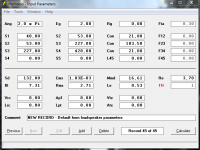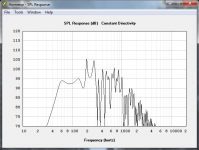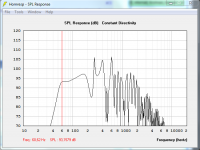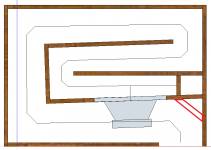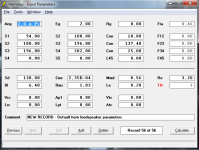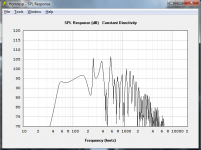So, I'm planning to build a tapped horn for some low-power mid-bass use. The size I'm aiming for will be something like martinssons THAM6, but with extension traded in for efficiency. It will be used on and in my boat, so 2 pi or worse in some cases and sometimes with help of cabin gain. I like to keep it portable to minimize theft risk.
The target is to match the rest of the system at 93 dB 1W/1m in 2pi, down to 50-60 Hz. Upper cut-off is maybe 130-150 Hz.
I'm planning to use a pair of Monacor SP60-4 plus tweeters for the rest of the spectrum, but that belongs in another forum. I'm planning to use a mini-DSP to create one setting for outdoors use and one for indoors, and deal with delays and EQ.
The power is coming from two (paralleled to one) of the four channels of a Tripath TAA4100A (AMP9). It does prefer low impedance, it delivers about 20 W in 4 ohm but only about 10 W is 8 ohm so that limits driver choice.
I'm not sure if a TH is really the best solution, but it seems to be quite OK size-wise and I'm interested to try it for its nice phase properties. After all I consider this to be an experimental build. Just like to run a sanity-check with you guys before I start to order stuff.
It seems the Silver Flute W17RC38-04 provides quite good price/performance ratio, see the hornresp simulations.
So I have some questions:
1. The Silver Flute has a Fs at 37.5 Hz. That is way low compared to what seems to be the general recommendation for a driver for a tapped horn, with regards to my current lower cut-off (about 60 Hz). What is the drawbacks of this? I have checked quite a few drivers, and it does not seems to be a very big difference.
2. Any obvious problems with the design?
3. Even though THs seems interesting, would I be way better off with a simple ported design and two Silver Flutes instead? It is not really clear how I compare winISD plots with those from hornresp. I don't really like to go above 30 liters in internal volume. Is TH still a reasonable way to go?
The target is to match the rest of the system at 93 dB 1W/1m in 2pi, down to 50-60 Hz. Upper cut-off is maybe 130-150 Hz.
I'm planning to use a pair of Monacor SP60-4 plus tweeters for the rest of the spectrum, but that belongs in another forum. I'm planning to use a mini-DSP to create one setting for outdoors use and one for indoors, and deal with delays and EQ.
The power is coming from two (paralleled to one) of the four channels of a Tripath TAA4100A (AMP9). It does prefer low impedance, it delivers about 20 W in 4 ohm but only about 10 W is 8 ohm so that limits driver choice.
I'm not sure if a TH is really the best solution, but it seems to be quite OK size-wise and I'm interested to try it for its nice phase properties. After all I consider this to be an experimental build. Just like to run a sanity-check with you guys before I start to order stuff.
It seems the Silver Flute W17RC38-04 provides quite good price/performance ratio, see the hornresp simulations.
So I have some questions:
1. The Silver Flute has a Fs at 37.5 Hz. That is way low compared to what seems to be the general recommendation for a driver for a tapped horn, with regards to my current lower cut-off (about 60 Hz). What is the drawbacks of this? I have checked quite a few drivers, and it does not seems to be a very big difference.
2. Any obvious problems with the design?
3. Even though THs seems interesting, would I be way better off with a simple ported design and two Silver Flutes instead? It is not really clear how I compare winISD plots with those from hornresp. I don't really like to go above 30 liters in internal volume. Is TH still a reasonable way to go?
Attachments
If your driver innately has a low Fs, you've lost efficiency over something with a higher Fs of the same diameter (Hoffman at work).
I'm gonna guess that the driver's a ~6.5" midbass, based on the model number (don't have time to look it up atm).
Try some PA drivers - the new Eminence Beta 6 looks interesting.
I suspect you could get similar extension using that driver and a ported box, but with a much smoother response and similar efficiency.
Chris
I'm gonna guess that the driver's a ~6.5" midbass, based on the model number (don't have time to look it up atm).
Try some PA drivers - the new Eminence Beta 6 looks interesting.
I suspect you could get similar extension using that driver and a ported box, but with a much smoother response and similar efficiency.
Chris
Look at the Eminence Beta 8A. In a tapped pipe about 140 cm long, with a cross-section of 220 cm^2, it can get down to 60 Hz @ 95dB/2.83V/1M in a net volume of about 31 litres.
At least, according to HornResp 🙂.
At least, according to HornResp 🙂.
@ Chris, Yes that explanation sounds reasonable. It does not really matter what driver parameter is changed to lower the fs, in the end it will always strike against efficiency I guess. The Silver Flute is a 6.5'' hifi woofer.
@ Both. The new Eminence Beta 6 and the Beta 8A are both 8 Ohm, so given the amplifier it looses about 3 dB max SPL and then there are no benefit over the SF, but I checked the old Beta 6C and it is really good, it can reach 60 Hz 93 dB/1W/1m in 4 Ohm, and only with 22 liters internal volume. I guess easier to build since it has constant expansion. See attached.
Thanks for pointing me towards the small Eminence Betas!
BTW I did the simulation of the Beta8A, quite impressive too.
@ Both. The new Eminence Beta 6 and the Beta 8A are both 8 Ohm, so given the amplifier it looses about 3 dB max SPL and then there are no benefit over the SF, but I checked the old Beta 6C and it is really good, it can reach 60 Hz 93 dB/1W/1m in 4 Ohm, and only with 22 liters internal volume. I guess easier to build since it has constant expansion. See attached.
Thanks for pointing me towards the small Eminence Betas!
BTW I did the simulation of the Beta8A, quite impressive too.
Attachments
Hm, or I could go to 50 Hz @ 93 dB with 33 liters, or 60 Hz @ 95 dB with 32 liters with the Beta 6C. Hm... maybe better to keep some dB headroom for "manufacturing tolerances".
Ummh... It should be Eminence Alpha 6C, not Beta....
Anyway! Finally I got my stuff together and learned Sketchup and folded the horn. I did not get it quite right so there is a little volume that is lost, but I only made one iteration to hornresp and back. I have planned to do the horn 20 cm deep, internally.
The new path length is a little longer. See attached new simulations of the folded design.
Question1: I have noted that some TH's with the mouth on the side has a 45 degree surface on the last bend. See how I suggested it in my sketchup drawing. What is the purpose of this, should I add that? How does that affect path length?
Question2: I have not taken any account of the back of the driver in the horn path. Does it affect a lot so late in the horn path? Also, if I take it into account, it is the projected area that I should consider or the volume (mass) of the air that is missing due to the driver?
Anyway! Finally I got my stuff together and learned Sketchup and folded the horn. I did not get it quite right so there is a little volume that is lost, but I only made one iteration to hornresp and back. I have planned to do the horn 20 cm deep, internally.
The new path length is a little longer. See attached new simulations of the folded design.
Question1: I have noted that some TH's with the mouth on the side has a 45 degree surface on the last bend. See how I suggested it in my sketchup drawing. What is the purpose of this, should I add that? How does that affect path length?
Question2: I have not taken any account of the back of the driver in the horn path. Does it affect a lot so late in the horn path? Also, if I take it into account, it is the projected area that I should consider or the volume (mass) of the air that is missing due to the driver?
Attachments
Its difficult to compensate for the presence of the driver in the pipe. Most ignore it, and still get results that are very close to simulation.
I'd view the 45 degree piece as optional. It won't affect the path length much, but would provide a slightly smoother exit. At these frequencies and SPLs, I really wouldn't expect much difference.
Chris
PS - would you be able to post dimensions of your folded drawing?
I'm working on a portable speaker, this would make a great additional woofer. I even have a similar driver waiting 😀
I'd view the 45 degree piece as optional. It won't affect the path length much, but would provide a slightly smoother exit. At these frequencies and SPLs, I really wouldn't expect much difference.
Chris
PS - would you be able to post dimensions of your folded drawing?
I'm working on a portable speaker, this would make a great additional woofer. I even have a similar driver waiting 😀
Last edited:
Question1: I have noted that some TH's with the mouth on the side has a 45 degree surface on the last bend. See how I suggested it in my sketchup drawing. What is the purpose of this, should I add that? How does that affect path length?
IMO it serves no purpose but to complicate the design. It's basically useless at bass frequencies.
Question2: I have not taken any account of the back of the driver in the horn path. Does it affect a lot so late in the horn path? Also, if I take it into account, it is the projected area that I should consider or the volume (mass) of the air that is missing due to the driver?
It will have an effect, the magnitude of which will depend on the cross-sectional area of the "horn" at that point. You may want to consider making the cross-sectional area slightly larger for that section of the horn to compensate for the effect.
Brian and Chris; great answers. Thanks!
Sure! I have added a zipped Sketchup file. Let me know if you can read it and if it works with your driver!
Ok, then it is almost time to place some orders!
PS - would you be able to post dimensions of your folded drawing?
I'm working on a portable speaker, this would make a great additional woofer. I even have a similar driver waiting 😀
Sure! I have added a zipped Sketchup file. Let me know if you can read it and if it works with your driver!
The s3 is 193 cm^2. Not sure how much the back of the driver takes away from that. So far only the depth in the drawing is correct, the rest is a guess. I will measure it once I have ordered it.It will have an effect, the magnitude of which will depend on the cross-sectional area of the "horn" at that point. You may want to consider making the cross-sectional area slightly larger for that section of the horn to compensate for the effect.
Ok, then it is almost time to place some orders!
Attachments
Ok, then it is almost time to place some orders!
I'm interested in how this turns out for you. The Alpha 6A doesn't strike me as a driver that will work well for midbass duty. Fs is a bit too high for my liking. I'd be tempted to look at using the B&C 6NDL44 instead. It's a much more expensive driver, but the lower Fs and higher Xmax should make it more suitable for loud midbass duty.
Just converted it to 3D and added dimensions.
You'll need the two side-panels, but its easy to get a cutlist from this.
I'm split between building this and a smaller ported box. Decisions...
Chris
Oh, thanks! Great! I think I need to revise my statement that I "learned" sketchup. Wrong tense, it should be "started to learn".
I'm happy if you try this design, but it does not come with any warranty. It is my first TH design you know 😉
I'm interested in how this turns out for you. The Alpha 6A doesn't strike me as a driver that will work well for midbass duty. Fs is a bit too high for my liking. I'd be tempted to look at using the B&C 6NDL44 instead. It's a much more expensive driver, but the lower Fs and higher Xmax should make it more suitable for loud midbass duty.
Yeah, I agree regarding the Fs but hornresp seems to be ok with it. I hope I have not made any major mistakes.
Actually one of the candidates I had from the beginning was the 6NDL38 which is fairly similar to the 6NDL44, but both of those are 8 Ohms drivers. The chip (TAA4100A) I'm planning to use gives almost the double output into 4 Ohms, so even though the B&C drivers models better the system max SPL will be almost the same and then the price difference is hard to justify!
Oh, thanks! Great! I think I need to revise my statement that I "learned" sketchup. Wrong tense, it should be "started to learn".
I'm happy if you try this design, but it does not come with any warranty. It is my first TH design you know 😉
There's some 9mm MDF at home (I'm at uni atm). If the pieces fit on that, I might well build it - its not perfect for my driver, but its not miles off either.
There are Sketchup tutorials online. IMO, its worth spending half an hour learning how to use it.
Chris
- Status
- Not open for further replies.
- Home
- Loudspeakers
- Subwoofers
- efficient mid-bass TH
